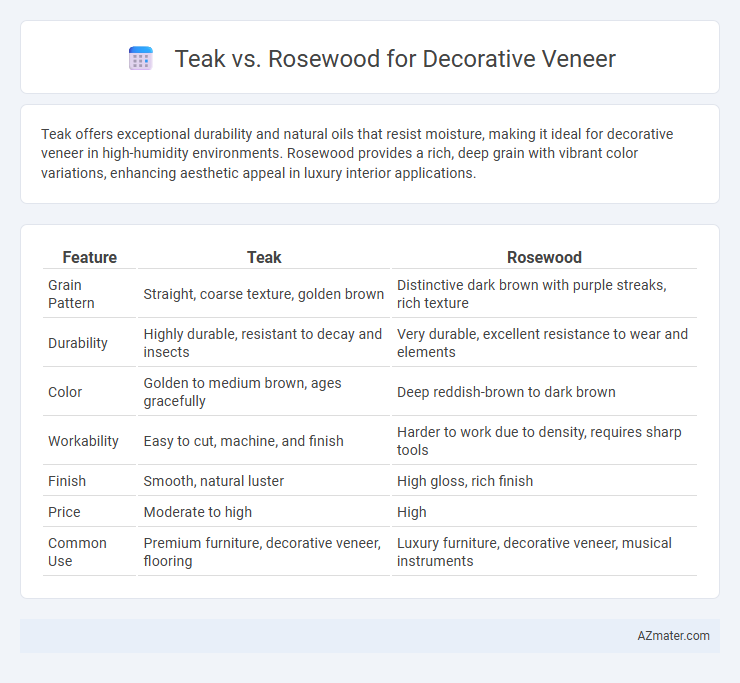Teak offers exceptional durability and natural oils that resist moisture, making it ideal for decorative veneer in high-humidity environments. Rosewood provides a rich, deep grain with vibrant color variations, enhancing aesthetic appeal in luxury interior applications.
Table of Comparison
| Feature | Teak | Rosewood |
|---|---|---|
| Grain Pattern | Straight, coarse texture, golden brown | Distinctive dark brown with purple streaks, rich texture |
| Durability | Highly durable, resistant to decay and insects | Very durable, excellent resistance to wear and elements |
| Color | Golden to medium brown, ages gracefully | Deep reddish-brown to dark brown |
| Workability | Easy to cut, machine, and finish | Harder to work due to density, requires sharp tools |
| Finish | Smooth, natural luster | High gloss, rich finish |
| Price | Moderate to high | High |
| Common Use | Premium furniture, decorative veneer, flooring | Luxury furniture, decorative veneer, musical instruments |
Introduction: Teak vs Rosewood Veneer
Teak veneer stands out for its durability, golden-brown hues, and natural resistance to moisture, making it ideal for both indoor and outdoor decorative applications. Rosewood veneer captivates with its rich, dark reddish-brown color and unique grain patterns, prized for luxury furniture and elegant interior accents. Both veneers offer distinct aesthetic and functional qualities, influencing their selection based on design preferences and environmental conditions.
Overview of Teak Veneer Characteristics
Teak veneer is renowned for its exceptional durability, natural oil content, and rich golden-brown color that deepens with age, making it highly resistant to moisture and decay. Its fine grain and smooth texture provide a luxurious finish ideal for high-end furniture and interior paneling. The veneer's stability and resilience under varying environmental conditions make it a preferred choice for both decorative and functional applications.
Overview of Rosewood Veneer Characteristics
Rosewood veneer is prized for its rich, dark hues ranging from deep brown to purplish tones, with striking grain patterns that often include swirls and fine streaks. It has a dense, durable texture that is resistant to wear and provides a luxurious, glossy finish, making it ideal for high-end decorative applications. Known for its natural oils, rosewood veneer resists moisture and decay, enhancing longevity while offering a sophisticated aesthetic unmatched by many other hardwood veneers.
Color and Grain Comparison
Teak veneer displays a golden to medium brown color with subtle, straight grain patterns that provide a warm, uniform appearance ideal for classic and modern decor. Rosewood veneer features a rich, dark brown to purplish hue with dramatic, swirling grain lines and complex chatoyancy, offering a bold, luxurious aesthetic. Color stability under light exposure favors teak, while rosewood's striking grain patterns make it a preferred choice for statement furniture and intricate inlays.
Durability and Hardness Differences
Teak veneer is renowned for its exceptional durability and natural resistance to decay, making it a preferred choice for long-lasting decorative surfaces in humid environments. Rosewood veneer, while also hard, offers superior density and a higher Janka hardness rating, providing enhanced scratch and wear resistance. The hardness difference typically places rosewood above teak, but teak's natural oils contribute significantly to its durability, especially in moisture-prone conditions.
Workability and Finishing Aspects
Teak offers excellent workability due to its moderate density and natural oils that enhance smooth cutting and sanding, making it ideal for fine veneers requiring intricate detailing. Rosewood, with its higher density and rich grain patterns, demands sharper tools and more careful handling to avoid chipping but delivers a luxurious finish with superior polishability and deep luster. Both woods respond well to various finishing methods, but rosewood's darker hues and natural oils often require tailored stains or sealants to maintain its vibrant appearance.
Sustainability and Sourcing Concerns
Teak, renowned for its durability and resistance to decay, faces sustainability challenges due to overharvesting and habitat loss in Southeast Asia, prompting increased reliance on certified plantations and FSC-approved sources. Rosewood, prized for its rich grain and color, is subject to strict international regulations under CITES due to illegal logging and depletion in native regions like India and Madagascar, complicating sustainable sourcing efforts. Choosing veneered products with transparent supply chains and certifications like FSC or PEFC ensures responsible use of both teak and rosewood materials while supporting conservation initiatives.
Cost and Market Value Analysis
Teak veneer commands a higher market value due to its natural oil content and durability, making it a premium choice for luxury furniture despite its costlier price. Rosewood veneer, while generally less expensive than teak, offers rich, dark hues and intricate grain patterns that remain highly sought after in decorative applications, providing strong value for mid-range budgets. Cost analysis shows teak veneer prices typically range from $30 to $50 per square foot, whereas rosewood veneer can vary between $20 and $40, influenced by species and sourcing legality.
Best Applications for Teak and Rosewood Veneer
Teak veneer is best suited for applications requiring high durability and water resistance, such as luxury furniture, yacht interiors, and high-end cabinetry, thanks to its natural oils and tight grain. Rosewood veneer, valued for its rich color and striking grain patterns, excels in decorative paneling, musical instruments, and fine furniture where aesthetic appeal is paramount. Both veneers enhance interior design with their unique textures, but teak prioritizes longevity under harsh conditions while rosewood emphasizes visual elegance.
Choosing the Right Decorative Veneer for Your Project
Teak and Rosewood are both premium choices for decorative veneer, with Teak offering exceptional durability and natural resistance to moisture, making it ideal for high-traffic areas or furniture exposed to varying humidity. Rosewood features a rich, dark grain with striking patterns that bring warmth and luxury, perfect for accent pieces or decorative panels where aesthetic impact is paramount. Choosing the right veneer depends on balancing factors like expected wear, environmental conditions, and desired visual appeal to ensure long-lasting beauty and functionality in your project.

Infographic: Teak vs Rosewood for Decorative Veneer
 azmater.com
azmater.com